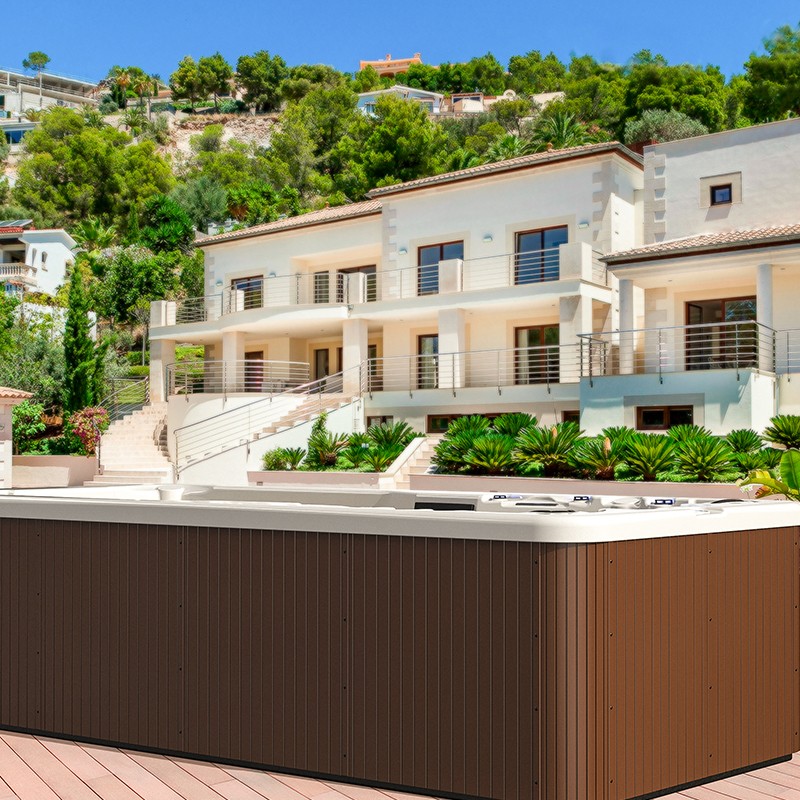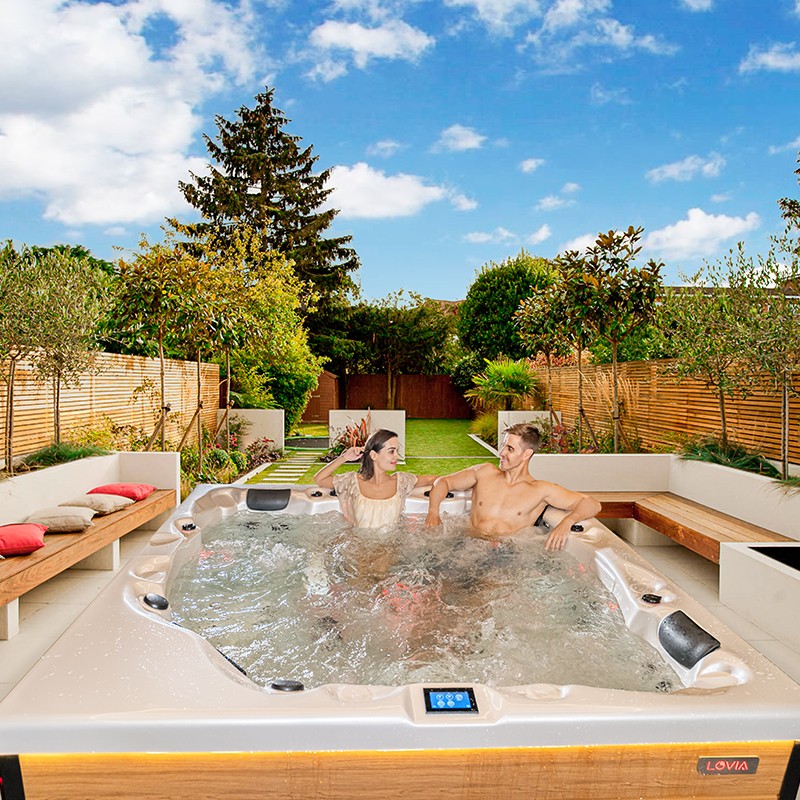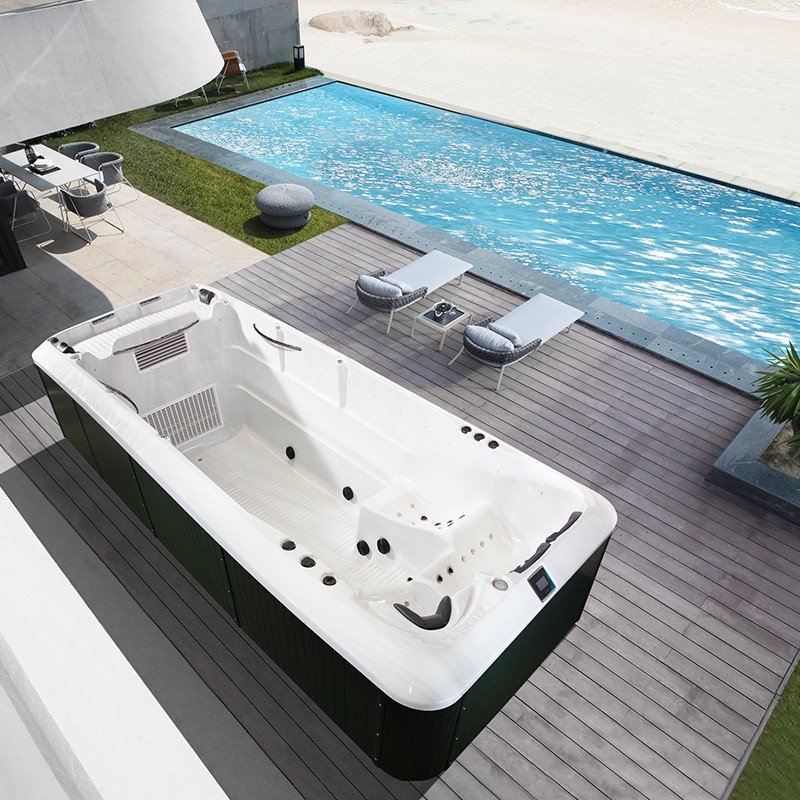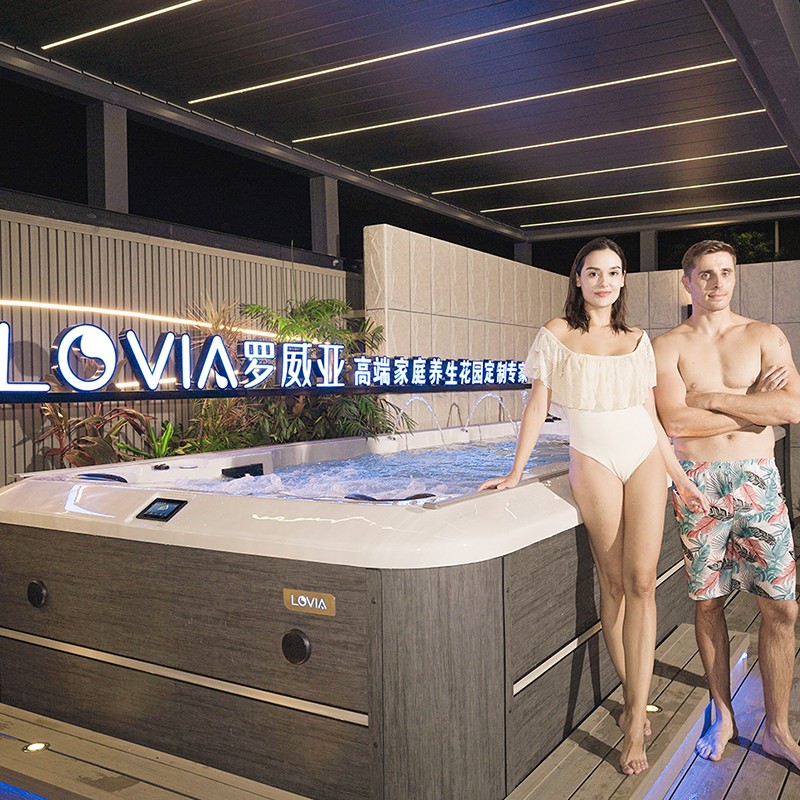
Can I use bleach to clean my swim spa hot tub filter?
2025-11-20 15:30Filter cleaning is a crucial step in maintaining a swim spa hot tub. The filter is responsible for trapping dirt, dander, grease, and microorganisms, keeping the water clear and clean. However, many users have a common question when cleaning their filters:
"Can I use bleach to clean my swim spa hot tub filter?"
On the surface, bleach seems to quickly kill bacteria and remove dirt, but is it really suitable for swim spa hot tubs? This article will provide a comprehensive answer from multiple perspectives, including chemical reactions, material properties, safety, and alternatives.

Why do swim spa hot tub filters need regular cleaning?
Swim spa hot tubs are typically equipped with a high-efficiency circulating filtration system to capture impurities in the water and prevent bacterial growth. If the filter is not cleaned regularly, it will lead to:
• Weakened water flow and uneven water output from the nozzles;
• Reduced filtration efficiency and cloudy water;
• Increased pump workload and energy consumption;
• Bacterial growth on the filter cartridge surface, affecting water hygiene.
Therefore, regular filter cleaning is a crucial step in maintaining the proper functioning of your spa system.
However, the key is that the cleaning method must be safe, gentle, and appropriate for the filter material.
What effect does the chemical composition of bleach have on a swim spa hot tub?
The main component of bleach is sodium hypochlorite (NaClO), a strong oxidizing agent commonly used for sterilization, bleaching, and stain removal.
While it is effective at eliminating mold and bacteria in a home environment, its use in swim spa hot tub components can pose potential risks.
1. Chemical Corrosion of Filter Material
Swim spa hot tub filters are typically made of polyester fabric or a plastic skeleton.
Sodium hypochlorite can disrupt the bond structure of polyester molecules, causing the filter media to become brittle, discolored, or even break.
This not only shortens the filter's lifespan but can also allow fine fibers to detach and enter the piping system.
2. Oxidation of Metal Components
Some swim spa hot tub filter cartridges contain metal screws or support rings at the bottom or in the housing. Bleach has strong oxidizing properties, which accelerate metal rusting and affect connection stability.
3. Damage to Rubber Seals
The filter element and filter tank are often sealed with rubber rings or silicone gaskets. Bleach breaks down rubber molecules, leading to poor sealing, water leakage, or insufficient pressure.
In summary, bleach's strong oxidizing properties make it unsuitable for cleaning swim spa hot tub filters.

Why do many people mistakenly believe that bleach is a safe cleaning method?
This misconception stems from the intuitive understanding that "bleach = disinfectant = strong cleaning power."
Indeed, bleach has a powerful disinfecting effect in kitchens, bathrooms, and laundry, so many users naturally regard it as a universal cleaner.
However, the environment of a swim spa hot tub filtration system is completely different from ordinary household surfaces.
It involves water circulation, electrical systems, and precision filter media, requiring not only decontamination but also consideration of water quality balance, pH stability, and equipment compatibility.
Simply put, while bleach has strong disinfecting power, its "destructive" properties are even greater.
In spa systems, such strong chemical reactions often do more harm than good.
What problems can bleach cause to the water quality of a swim spa hot tub?
Even after simply soaking and rinsing with bleach, chemical residues may still enter the spa system, disrupting the overall water balance. Common risks include:
1. pH Imbalance
Bleach is highly alkaline (pH approximately 11–13). Trace amounts remaining in the filter can enter the tub, raising the water's pH, leading to skin irritation and cloudy water.
2. Excessive Chlorine Concentration
The active chlorine released by bleach may react with disinfectants in the system to form harmful compounds such as chloramine, giving the water an irritating odor.
3. Skin and Respiratory Irritation
Residual bleach may mix with hot water steam during circulation, irritating the respiratory tract and skin, especially unsafe for those with allergies or children.
4. Long-term effects on equipment
Excessively alkaline environments can corrode metal parts such as pipes, pumps, and heating elements, shortening the lifespan of the entire system.
Therefore, bleach is not only unsuitable for cleaning filters, but may also indirectly affect the water quality safety of the entire swim spa hot tub.

If bleach cannot be used, what should be used to clean the swim spa hot tub filter?
The correct cleaning method should remove grease and impurities without damaging the filter element structure or affecting water quality. The following methods are safer and more effective:
1. Use a dedicated filter cleaner
There are cleaning solutions specifically designed for swim spa hot tub filters on the market. They are usually neutral or weakly acidic formulas that can dissolve grease and impurities without damaging the filter element.
Instructions for use:
• Immerse the filter in a diluted cleaning solution (approximately 1:10 ratio);
• After soaking for 3–4 hours, rinse thoroughly with clean water;
• Allow to dry completely before reinstalling.
2. Use a white vinegar solution
White vinegar is a natural detergent. Diluting white vinegar and water in a 1:1 ratio can effectively remove mineral deposits.
However, note that although white vinegar is mild, it should not be used for soaking for more than 12 hours to avoid damaging the filter cartridge structure.
3. High-Pressure Water Rinse
After each use of the swim spa hot tub, use a high-pressure water gun to rinse the filter cartridge from top to bottom to remove surface dirt.
This is a physical cleaning method and can be used in conjunction with periodic deep cleaning.
4. Replace the Filter Cartridge
If the filter cartridge is old, deformed, or difficult to clean thoroughly, it should be replaced promptly. Most manufacturers recommend replacement every 6 months to 1 year, depending on usage frequency and water quality.
Why is a thorough filter rinse a critical step?
Regardless of the cleaning method used, a thorough rinse is the most critical step.
If cleaning agent residue remains in the filter cartridge, it will enter the circulating water during the next use, causing chemical reactions or an irritating odor.
Proper Rinsing Method:
• After using detergent, rinse with clean water for at least 5 minutes;
• Gently scrub the folds with your hands to ensure no foam residue remains;
• Allow to air dry before reinstalling to prevent mold growth in a damp environment.
Thorough rinsing not only protects the filter cartridge itself but also maintains the healthy operation of the entire swim spa hot tub system.

How to determine if the swim spa hot tub filter is thoroughly clean?
Judgment criteria include the following:
• Appearance: The filter cloth surface is clean with no obvious oil stains or discoloration;
• Feel: The filter cartridge has no sticky feel or bleach odor;
• Water Flow: After installation, the nozzle water pressure is normal, with no feeling of blockage;
• Odor: The water is fresh and has no chemical smell;
• Foam: If the foam has significantly decreased, the filtration system has returned to normal.
If an odor or poor water flow persists, it should be cleaned again or the filter cartridge should be replaced.
Are there any safe and controlled ways to use bleach?
Strictly speaking, bleach in swim spa hot tub maintenance should only be used for spot cleaning of external hard surfaces, such as floors or the outer casing, and must never come into contact with internal components such as filters, pumps, and nozzles.
Even when used externally, the following principles must be followed:
• Dilute at least 1:50;
• Avoid mixing with other cleaning agents (especially acids);
• Rinse thoroughly with plenty of water after use;
• Ensure bleach does not seep into the spa system.
In short, bleach is only suitable for external cleaning and should never be used on the internal circulation system.
How does cleaning frequency affect filter lifespan?
Even with the correct cleaning agent, over-cleaning can loosen the filter fiber structure and shorten its lifespan.
Recommended frequencies are as follows:
• Daily rinsing: Once a week, simply rinse with water;
• Deep cleaning: Once a month, soak in a specialized cleaning agent;
• Regular replacement: Replace the filter every 6–12 months.
Proper cleaning frequency not only maintains filtration effectiveness but also extends the overall lifespan of the filter cartridge and the swim spa hot tub.
How to ensure the cleanliness of the entire swim spa hot tub system?
The filter is only one part of the overall system maintenance. To maintain overall hygiene, the following measures should be taken simultaneously:
• Regularly check water balance (pH 7.2–7.8);
• Check disinfectant concentration (chlorine or bromine) weekly;
• Regularly clean the nozzles and water pump inlet;
• Turn off the power when changing or cleaning the filter;
• Keep the water cover clean to prevent dust from entering.
These habits will significantly reduce system contamination, making the spa experience safer and more comfortable.
Why is it not recommended to use bleach to clean the swim spa hot tub filter?
In summary, although bleach has excellent bactericidal power, its strong oxidizing properties and high alkalinity can cause long-term damage to the filter cartridge, seals, and system water quality.
• The correct approach is to use:
• A dedicated filter cleaner, or
• A diluted white vinegar solution for gentle cleaning.
After cleaning, be sure to rinse and dry thoroughly, and adhere to a reasonable cleaning frequency.
Remember, bleach is a high-risk chemical and is not suitable for the filtration system of your swim spa hot tub. Scientific maintenance and proper cleaning are essential to ensure your spa equipment remains in optimal condition, providing a truly safe, relaxing, and healthy user experience.
How Does LOVIA SPA Control Product Costs and Maintain Low Prices?
Our low price advantage stems from efficient production management, bulk purchasing of materials, and automated assembly systems. As a manufacturer with decades of experience, LOVIA SPA operates its own mold and acrylic forming facilities, allowing for direct cost control. Buyers receive competitive quotes and transparent prices with no hidden fees. Despite the affordable pricing, every spa maintains high quality and CE/ETL certification.
